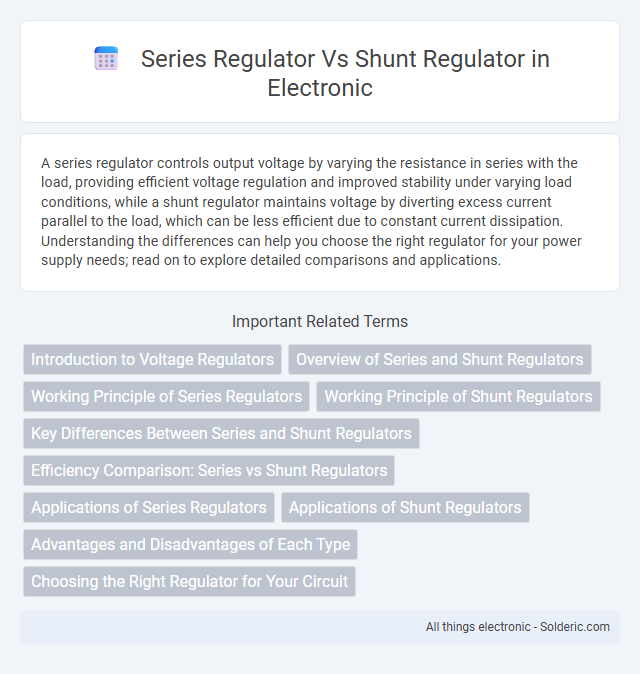A series regulator controls output voltage by varying the resistance in series with the load, providing efficient voltage regulation and improved stability under varying load conditions, while a shunt regulator maintains voltage by diverting excess current parallel to the load, which can be less efficient due to constant current dissipation. Understanding the differences can help you choose the right regulator for your power supply needs; read on to explore detailed comparisons and applications.
Comparison Table
| Feature | Series Regulator | Shunt Regulator |
|---|---|---|
| Function | Regulates voltage by varying resistance in series with load | Regulates voltage by shunting current around load |
| Configuration | Connected in series with load | Connected in parallel (shunt) with load |
| Efficiency | Higher efficiency, less power wasted | Lower efficiency, more power dissipated as heat |
| Current Handling | Handles load current directly | Requires higher current capacity in shunt element |
| Voltage Drop | Higher dropout voltage possible | Usually small voltage drop, depends on shunt element |
| Complexity | More complex, typically uses pass transistor | Simple design, often uses zener diode |
| Load Regulation | Better load regulation | Weaker load regulation |
| Cost | Generally higher cost | Lower cost |
| Use Cases | Stable DC power supplies, high-current applications | Low-power voltage references, simple circuits |
Introduction to Voltage Regulators
Series regulators maintain a constant output voltage by varying the resistance in the series path between the input and the load, optimizing power efficiency and heat dissipation. Shunt regulators regulate voltage by shunting excess current to ground, offering simpler design but typically higher power loss. Both voltage regulator types ensure stable output despite input voltage fluctuations or load variations, crucial for sensitive electronic devices.
Overview of Series and Shunt Regulators
Series regulators control output voltage by varying the resistance of a series pass transistor, ensuring stable voltage under varying load conditions with high efficiency and low power dissipation. Shunt regulators maintain output voltage by diverting current through a parallel path, offering simplicity and fast response but lower efficiency due to continuous current flow. Your choice between series and shunt regulators depends on the required voltage stability, power efficiency, and circuit complexity for your application.
Working Principle of Series Regulators
Series regulators maintain a constant output voltage by varying the resistance of a pass transistor placed in series with the load, adjusting current flow according to voltage changes. The transistor acts as a variable resistor controlled by an error amplifier comparing the output voltage with a reference voltage. This ensures your electronic device receives a stable voltage despite fluctuations in input voltage or load conditions.
Working Principle of Shunt Regulators
Shunt regulators maintain voltage stability by diverting excess current through a parallel resistor or transistor, effectively regulating voltage across the load. Unlike series regulators that control voltage by varying resistance in series with the load, shunt regulators operate by shunting current to ground when voltage exceeds the desired level. Your circuit benefits from a simple design and fast response in low-current applications using shunt regulators.
Key Differences Between Series and Shunt Regulators
Series regulators control output voltage by varying the resistance in the series path between the input and load, offering high efficiency and better voltage regulation for varying load conditions. Shunt regulators maintain voltage by diverting excess current through a parallel path to ground, making them simpler but less efficient and suitable for low current applications. Your choice depends on load requirements, with series regulators preferred for higher currents and shunt regulators for simpler, low-power circuits.
Efficiency Comparison: Series vs Shunt Regulators
Series regulators offer higher efficiency by regulating voltage through a transistor in series with the load, minimizing power dissipation compared to shunt regulators, which operate by diverting excess current to ground. Shunt regulators tend to waste more power as heat because they continuously draw current regardless of load variations, making them less energy-efficient. Your choice of regulator impacts overall system efficiency, with series regulators typically favored for applications requiring lower power loss and better thermal management.
Applications of Series Regulators
Series regulators are commonly used in applications requiring precise voltage control, such as power supplies for microprocessors, audio equipment, and sensitive analog circuits. Their ability to maintain a stable output voltage despite variations in input voltage and load current makes them ideal for battery-operated devices and communication equipment. Your devices benefit from the low noise and high efficiency provided by series regulators in demanding electronic environments.
Applications of Shunt Regulators
Shunt regulators are commonly used in low-power applications such as voltage reference circuits, small signal conditioning, and power supplies for analog circuits due to their simplicity and ability to maintain a constant voltage by shunting excess current. They are ideal for stabilizing voltage in battery-powered devices and provide efficient regulation in circuits with low load currents. Your choice to use a shunt regulator is optimal when precise voltage control is needed in compact, low-current environments.
Advantages and Disadvantages of Each Type
Series regulators provide excellent voltage regulation with high efficiency, as they vary the resistance in series with the load to maintain a steady output voltage; however, they generate heat and have limited current capacity. Shunt regulators offer simplicity and fast response by diverting excess current away from the load, making them suitable for low-current applications, but they are less efficient and waste power as heat. Series regulators are preferred in high-current, battery-powered devices for their efficiency, while shunt regulators suit low-power circuits requiring stable voltages with minimal complexity.
Choosing the Right Regulator for Your Circuit
Selecting the appropriate voltage regulator depends on your circuit's load requirements and efficiency priorities. Series regulators offer better efficiency and thermal management by controlling the current through a pass transistor, ideal for varying load conditions. Shunt regulators provide simplicity and low noise in low-power applications but are less efficient, making them suitable for circuits where minimizing complexity outweighs power loss.
series regulator vs shunt regulator Infographic

 solderic.com
solderic.com